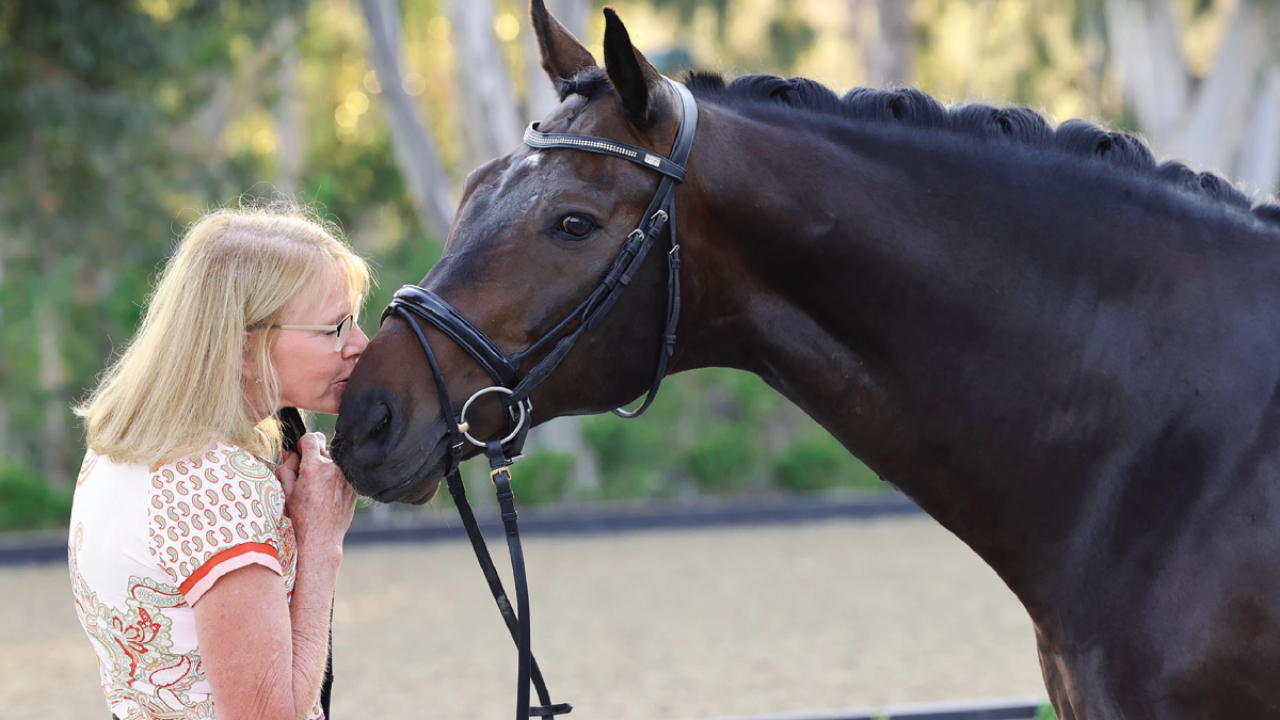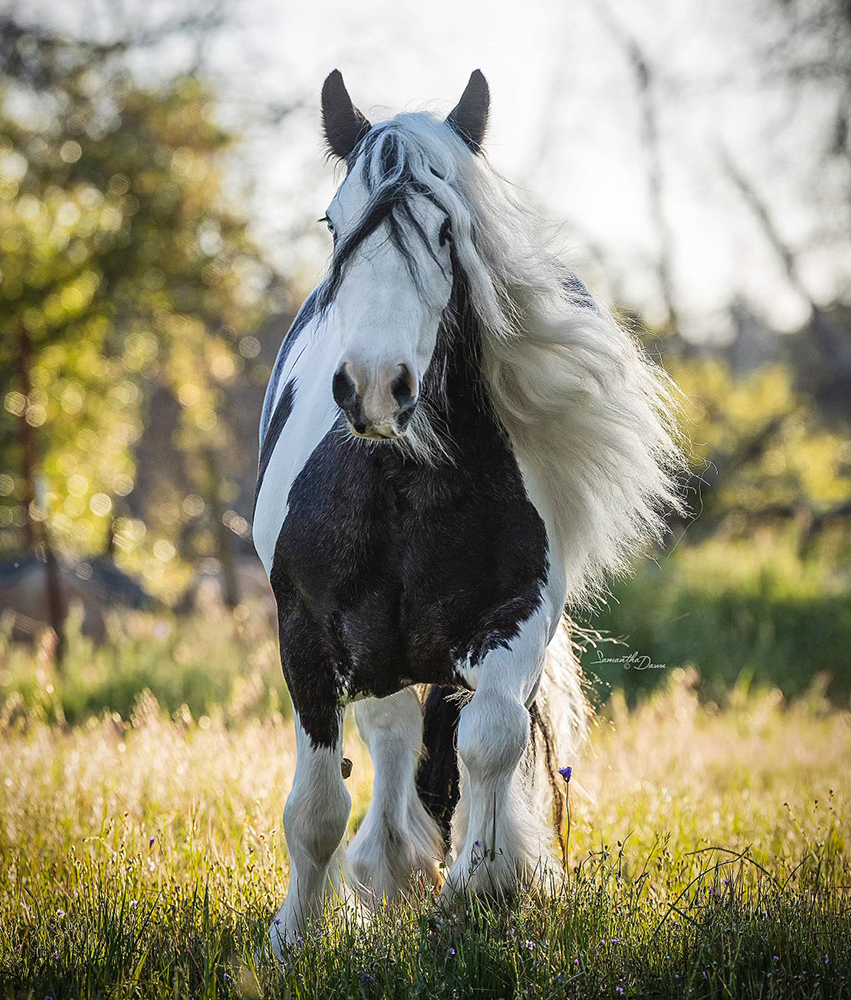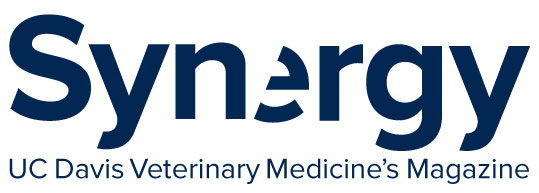
Clinical Updates
Equine and livestock specialists at the UC Davis veterinary hospital’s Large Animal Clinic constantly seek to optimize standard of care. With advancements in research, collaborative treatments, and innovative procedures, they continue to raise the bar.
Making Strides in Standing Surgery
Frank Sinatra, a 14-year-old Hanoverian horse (pictured above), is a testament to the advancement of standing surgeries for horses. The dressage athlete was continually getting nose bleeds and experiencing exercise intolerance with heavy breathing. Since he was already seeing the Equine Integrative Sports Medicine Service for routine maintenance and chiropractic care, owner Lori Kornblatt brought up the issues at his recurring appointment. Frank’s life was about to completely change.
Radiographs and a CT scan revealed what was causing Frank’s problems. Both of his nasal passages were nearly filled with foreign masses. The right side contained two paranasal sinus cysts, and an ethmoid hematoma filled the left frontal sinus.
Two surgeries—several months apart to allow proper healing—were needed to address the problems. Both involved sawing a flap into the nasal bone to allow access to the sinus and remove the foreign bodies. Remarkably, the Equine Surgery Service accomplished these invasive surgeries while Frank was standing and only sedated, rather than fully anesthetized.
Surgeries made safer through the shift to standing only sedation.
With the opening of the All Species Imaging Center on the horizon, UC Davis will soon acquire an equine standing CT scanner, eliminating the need to fully anesthetize horses to scan their heads, necks, and torsos.
“I’ve had other horses undergo sinus surgeries, and they were all under full anesthesia,” said Kornblatt. “It’s amazing what can be done now.”
Surgeries are not the only procedures made safer through the shift to standing only sedation. Imaging equipment has advanced quickly over the past few years to upgrade to standing versions, primarily PET and CT scanners. With the opening of the All Species Imaging Center on the horizon, UC Davis will soon acquire an equine standing CT scanner, eliminating the need to fully anesthetize horses to scan their heads, necks, and torsos.
Kornblatt reports that Frank is back in competition shape thanks to his now clear nasal passages. Prior to surgery, she trained him for competition through dressage Intermediate 1 level, and he rose to become the California Region 7 champion in the adult amateur category. Frank is currently being schooled at the Grand Prix level—the highest competition level in dressage—with the goal of competing in the next show season.

Establishing Baselines in Mini Pigs
Hamilton, a 4-year-old miniature pig, was the first participant in a study of healthy adult mini pigs to establish baseline ranges for several parameters in blood tests, including blood clotting times and electrolyte values. Currently there are no reference ranges established for a healthy mini pig in several important bloodwork parameters.
“Companion mini pigs are becoming very popular pets, but there is a lack of information about providing evidence-based care for them beyond standards of care for use as animal research models,” said livestock medicine specialist Dr. Grace VanHoy, co-principal investigator on the study, along with clinical pathologist Dr. Melanie Ammersbach.
Mini pigs make up 20% of the caseload for the Livestock Medicine and Surgery Service, with visits commonly including routine wellness appointments, elective spays, lameness, and gastrointestinal issues.
Bloodwork is a primary diagnostic tool used in the evaluation of mini pig health. Reference intervals have been published for complete blood counts and serum biochemistry profiles in this porcine population, but not for other commonly performed blood tests such as blood gases and coagulation profiles. Evaluation of coagulation is done before surgical procedures during and after which excessive bleeding could occur. Detecting coagulation abnormalities could allow veterinarians to prevent complications before the procedure.
The study’s goal is testing 100 mini pigs. VanHoy believes they should be able to gather those samples within a year. DVM student Laney Stephens, Class of 2026, is helping the faculty to compile data through the Students Training in Advanced Research program as her first research project.

Collaborative Care Saves Mare
Fannie’s first foal was a difficult birth, so her owner Alycia Campidonica planned to have the 7-year-old Gypsy Vanner horse birth the second time at her veterinarian’s facility.
“But our veterinarian called us shortly after we dropped her off and said, ‘You’d better get Fannie to Davis,’” said Campidonica. “Something wasn’t right with the presentation of the foal. She thought maybe it was breach.”
Based on palpation and ultrasound findings, the Equine Reproduction Service diagnosed Fannie’s foal as malpositioned and most likely non-viable as a result. The reproduction team quickly organized a meeting with the Anesthesia, Equine Internal Medicine, and Equine Surgical Emergency and Critical Care Services to plan for a potential C-section.
The team waited until Fannie started foaling on her own in the early morning hours a few days later. The Foal Alert system did not function, as no part of the fetus could engage in the pelvic canal, which was predicted due to its malposition. Fannie was sent immediately to surgery for a C-section.
The surgeons delivered a stillborn foal which was confirmed to be a non-viable fetus with an abnormal spine. But the surgery saved Fannie’s life. “We can’t express how grateful we are for everyone UC Davis for saving Fannie,” Campidonica said. “It was such an amazing journey, and the team’s professionalism was incredible.”
Campidonica reports that Fannie had no complications after returning home. She hopes that Fannie can successfully breed next year as part of her family’s breeding organization that produces show and pleasure horses.

Alternative Treatments for Llama with Seizures
Alibobbi, a 3-year-old llama, was raised by humans, hand-fed as a cria and unsocialized with adult llamas. Owner Cindy Vandenboom rescued him when he was a year old and immediately noticed abnormalities including seizures, separation anxiety, and dangerous behavior. She brought him for examination by the Equine Internal Medicine Service, one of the very few services in the country with a board-certified large animal neurologist.
Alibobbi underwent a thorough neurological exam, bloodwork, and an MRI, which did not reveal any tumors or lesions in his brain.
“The equipment technology plays such a big role in UC Davis’ ability to offer the best care,” Vandenboom said. “I could not get an MRI at any of the other veterinarians we visited.” Based on the signs, he was diagnosed with idiopathic epilepsy that appeared to be triggered by high emotional states such as excitation and anxiety. Seizures can also be associated with hormones. Therefore, Alibobbi was castrated in hopes of better controlling his male dominant behavior.
The equipment technology plays such a big role in UC Davis’ ability to offer the best care. I could not get an MRI at any of the other veterinarians we visited.”
—Cindy Vandenboom
He was also started on behavioral modification exercises while hospitalized. For example, his attention was redirected away from humans using treats. Vandenboom has continued the behavioral modification in Alibobbi’s home environment, where it is less stressful for him. She was encouraged to promote a “normal animal life” for him and help him attach to his herd mates instead of people. He now stays in the company of several other llamas and horses, experiencing minimal human contact.

“He was never taught to be a llama,” said Vandenboom. “This modification is teaching him to be a llama and to recognize that humans are not the same as llamas. He needs to learn that we are not his herd mates. He thinks we are and cannot identify us as different because he was brought up being human imprinted.”
Vandenboom has noticed a significant decrease in the number and severity of his seizures, as well as patterns of lessening violent and dangerous behavior. But her work is not done. She knows that for the modification to be successful, it will take consistency over many months.
“He’s one of the sweetest animals you’ll ever meet,” said Vandenboom. “If anyone deserves a chance, it’s him. So, I want to do the best I can for him.”
